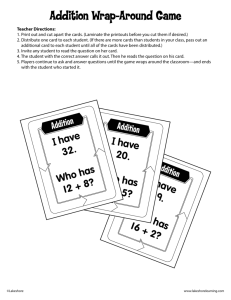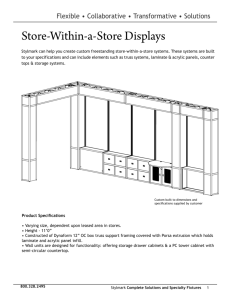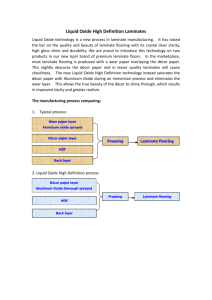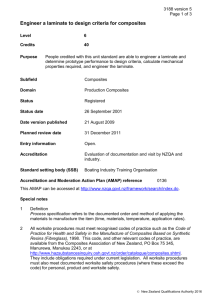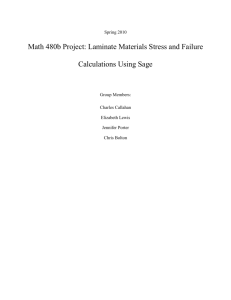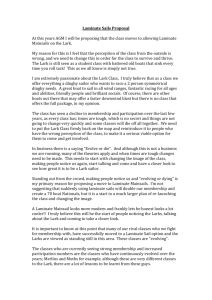Lab 4 composite laminates design (starts Feb 8)
advertisement
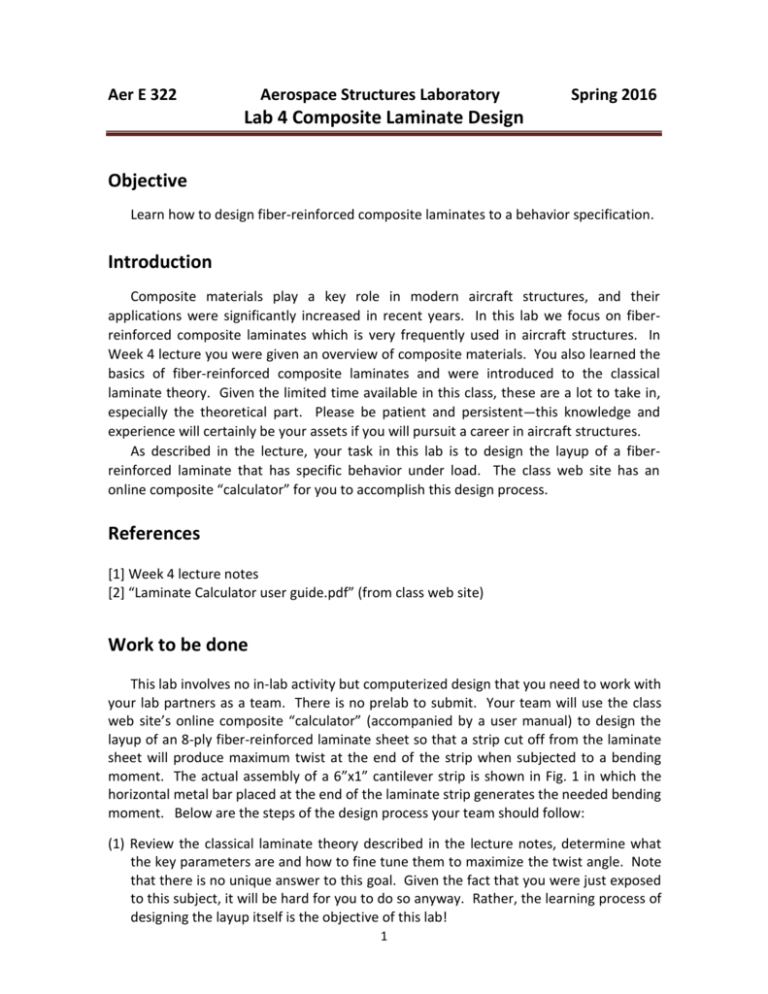
Aer E 322 Aerospace Structures Laboratory Spring 2016 Lab 4 Composite Laminate Design Objective Learn how to design fiber-reinforced composite laminates to a behavior specification. Introduction Composite materials play a key role in modern aircraft structures, and their applications were significantly increased in recent years. In this lab we focus on fiberreinforced composite laminates which is very frequently used in aircraft structures. In Week 4 lecture you were given an overview of composite materials. You also learned the basics of fiber-reinforced composite laminates and were introduced to the classical laminate theory. Given the limited time available in this class, these are a lot to take in, especially the theoretical part. Please be patient and persistent—this knowledge and experience will certainly be your assets if you will pursuit a career in aircraft structures. As described in the lecture, your task in this lab is to design the layup of a fiberreinforced laminate that has specific behavior under load. The class web site has an online composite “calculator” for you to accomplish this design process. References [1] Week 4 lecture notes [2] “Laminate Calculator user guide.pdf” (from class web site) Work to be done This lab involves no in-lab activity but computerized design that you need to work with your lab partners as a team. There is no prelab to submit. Your team will use the class web site’s online composite “calculator” (accompanied by a user manual) to design the layup of an 8-ply fiber-reinforced laminate sheet so that a strip cut off from the laminate sheet will produce maximum twist at the end of the strip when subjected to a bending moment. The actual assembly of a 6”x1” cantilever strip is shown in Fig. 1 in which the horizontal metal bar placed at the end of the laminate strip generates the needed bending moment. Below are the steps of the design process your team should follow: (1) Review the classical laminate theory described in the lecture notes, determine what the key parameters are and how to fine tune them to maximize the twist angle. Note that there is no unique answer to this goal. Given the fact that you were just exposed to this subject, it will be hard for you to do so anyway. Rather, the learning process of designing the layup itself is the objective of this lab! 1 Aer E 322 Aerospace Structures Laboratory Spring 2016 Lab 4 Composite Laminate Design (2) The online calculator can be accessed from the main page of class web site on the left panel under “Interactive Laminate Calculator”. Also from the left panel under “Notes and Assignments” you can find the companied user manual in the rightmost “Misc Documents” column. (3) You will notice that most inputs to the online calculator have been pre-filled for you. Those inputs, e.g. material properties, are good approximations for some common materials which you don’t need to change. To begin, you just modify the layer thickness (t_layer under Laminate tab on the left side panel) to 150 m, and zero out any applied stress in x direction, sigma_x, on the right side panel. (4) Apply a nominal bending moment (say M_x = 1 N-m/m) and calculate the curvatures/twists as shown in Fig. 2 in the encircled kappa column. The three components from top to bottom in the kappa column corresponds to the bending curvatures x and y and twist curvature xy described on page 20 of the lecture notes. It is the twist curvature xy controls the twist at the end of the laminate strip in the “virtual test” you will be conducting (Fig. 1). (5) Play with your layup design and see how it affects these curvatures, particularly xy. Since your objective is to maximize the twist at the end of the strip, should you “randomize” your laminate layup (more of [0, 90, 45, -45, ….]) or “unify” it (more of [45, 30, 45, 30, …])? Note that since the laminate is symmetric you only need to enter half (i.e. four) of the layup entries (in layup under Laminate tab on the left panel). Don’t be confused by the deformation plot provided in the online calculator (shown in blue frame on the lower right corner of Fig. 2). The plot only shows the top view of the strip, and does not show the side view of the twist of the strip. (6) (10%) Of the A-B-B-D matrices shown on pages 22-23 of lecture notes, which component affects the curvatures? (7) (90%) In at least 5 design cycles, show how to reach your final largest twist curvature xy and thus the largest twist angle at the end of the laminate strip. Included in each cycle are: (a) The design layup you choose, (b) The reasoning that leads to your choice, and (c) The value of twist curvature xy obtained from the online calculator 3. Report Write a summary for this design process. Create a section with heading “Design Process” and put all results of the design process there. Be sure to include all other standard components (Introduction, Objectives, etc.) as in a normal summary report. This summary is due 11:59pm, Saturday, Feb. 20 (ALL sections). 2 Aer E 322 Aerospace Structures Laboratory Spring 2016 Lab 4 Composite Laminate Design Figure 1. Laminate test assembly Figure 2. The graphical user interface of the online laminate calculator 3

